REFLECTIONS OF STEPHANIE, JESSICA AND RONNIE ON VOLUNTEERING IN PANAJACHEL WITH MAYAN FAMILIES.
Problems on a Different Plane in Pana
We’ve been in Panajachel for two weeks now, and we’re starting to get to know it well enough to introduce it to you, though I’m sure we still have a lot left to learn. Pana is very different from San Andres. It’s a larger city (there’s a grocery store–actually, there’s more than one!), and it has a significant tourism industry–we’re not the only gringos anymore.
Actually, the demographics of Pana are very mixed, and a walk down the street will reveal at least five distinct groups: backpackers (identifiable by an apparent shortage of shampoo, and giant backpacks), tourists (like the backpackers, but with cleaner hair), ex-pats (like the tourists, but with more permanent housing), ladinos (Spanish-speaking, non-indigenous Guatemalans), and indigenous people. Indigenous people, especially in the more remote villages around Panajachel, speak primarily Kaqchiquel. That means that despite our diligent Spanish studying, we’re sometimes finding ourselves back to trying to communicate through hand gestures or translators. Luckily, most of Mayan Families’ staff speaks Kaqchiquel, but the extra layer of translation certainly complicates a conversation.
I can’t talk long without talking about the geography here, because it affects so much about the place. We’re right on the edge of Lago Atitlán, which is the biggest lake in Guatemala. The surface of the lake is about mile above sea level, and the surrounding land is even higher, so it’s much colder here than in Petén. Three volcanoes–Volcán Atitlán, Volcán Tolimán, and Volcán San Pedro–surround the lake, and the way the mountains rise straight out of the water has a way of making you feel very, very small.
This landscape, while breathtaking, has caused an incredible amount of suffering for the people of the Lago Atitlan region. For the villages poised on the steep mountainsides around the lake, the intense rainy season brings the constant threat of derrumbes (mudslides), which can destroy roads, topple buildings, and bury homes.
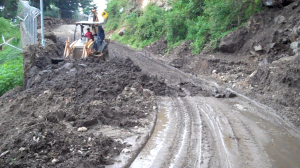
A bulldozer clears a road blocked by lodo (mud) from a derrumbe. The roads to Pana are often impassible after it rains.
These villages are mostly poor, and the most vulnerable families often live in homes made of little more than wood and sheet metal (or even nylon tarp), so it doesn’t take a lot of mud or water to cause complete destruction.
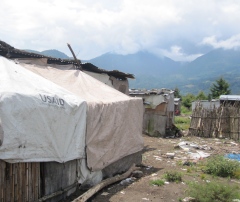
Unfortunately, families in the most vulnerable areas are often the poorest, and their homes the least able to withstand extreme weather. This home belongs to a family that lost everything during Hurricane Stan in 2005.
When disasters strike, few families have the means to rebuild, so they must rely on foreign aid, help from NGOs (non-governmental organizations like the Red Cross or Oxfam), or assistance from the government, to get back on their feet. During a recent trip to distribute food in the town of Chuk Muk, Jess and I met a family of about 10 that was still living in a shack made of scrap wood and USAID tarps, five years after hurricane Stan destroyed their home.
I probably don’t need to point out that the poverty here is more striking than that in San Andres–malnutrition and hunger are unavoidably visible, and the wreckage from past storms can be seen by driving in any direction (in many cases it is the road itself that is wrecked). Our activities as volunteers have shifted accordingly; in Petén, we focused on creating opportunities for the next generation to take advantage of and build a better future. With Mayan Families, we’ve been organizing and handing out food and clothing to those affected by the recent storms, and bringing food and medical care to ancianos (elderly people) who would otherwise go without them. You might compare what Volunteer Petén tries to do in San Andres to unclogging a blocked artery–trying to address a problem (the failing education system) that could cause disaster in the future. What we’re doing now with Mayan Families is more like CPR–just trying to keep the heart beating until the underlying issues can be addressed.
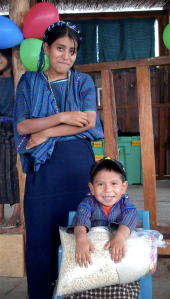
A student and his mother receive a supply of food. 80% of the students at this Mayan Families-run preschool in the town of San Antonio lost or evacuated their homes earlier this year.

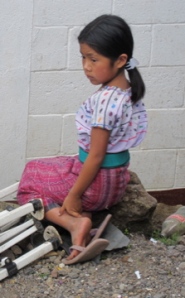
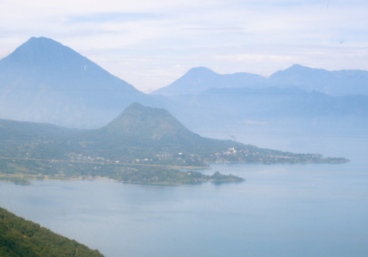


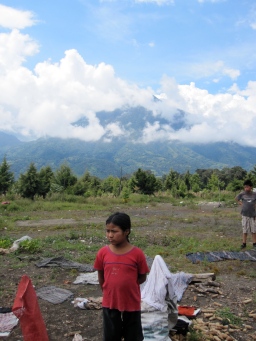






No comments:
Post a Comment